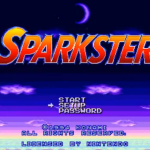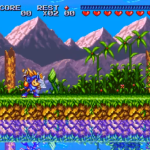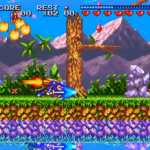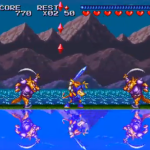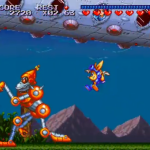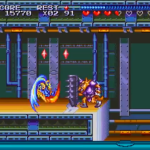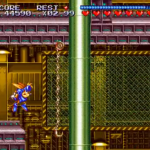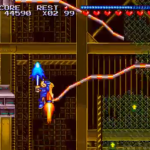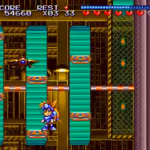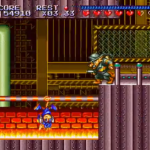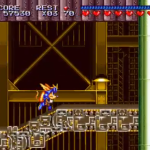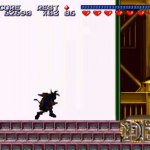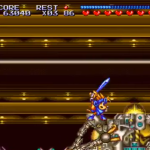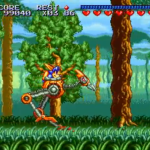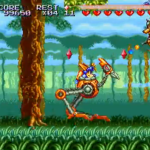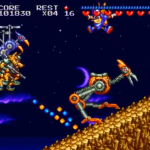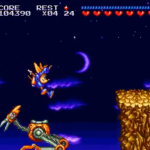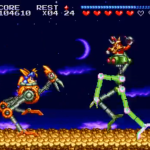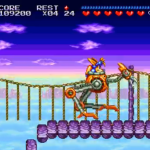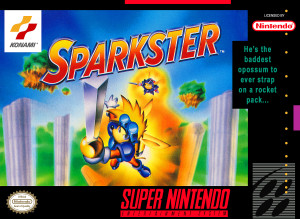
Author: John Legendoffzelda
He may be “the baddest opossum to ever strap on a rocket pack”, but the title character of Konami’s Sparkster is still caught in a strange position with his sole outing on the Super Nintendo. Sparkster’s debut, the 1993 Sega Genesis game Rocket Knight Adventures, is considered one of the console’s definitive titles. The praise is appropriate, since out of all the post-Sonic “cool” animal mascots of the fourth generation, Sparkster is perhaps the blue force of personality’s only equal. The Super Nintendo’s own Rocket Knight adventure, released in 1994 and directed by Axelay’s Hideo Ueda, should by all accounts be an equal to the Genesis. But while still a more than decent action game, it isn’t really a similar experience.
The Sparkster games are based on a formula that’s one-part Sonic the Hedgehog and one-part Contra. Sparkster, a little opossum and ordained Rocket Knight, spends whichever game he’s in going through his kingdom equipped with a jetpack and a sword. Names and enemies change with each installment, and in the case of Sparkster, the kingdom is named Eginasem. The kingdom comes under the threat of destruction from the nefarious Generalissimo Lioness. Aiding him is the turncoat knight Axel Gear, who does his part in the Generalissimo’s scheme by kidnapping the fair Princess Flora. The Contra part consists of movement and combat, and how the player uses Sparkster’s sword. His sword takes out enemies by flinging a sort of projectile at them, which allows for long-range combat and creates a neat visual effect. Being an opossum, Sparkster also moves along poles and tree branches and dangles from them with his tail, and can continue to swing his sword while upside-down.
The game also features the ability to move horizontally by “rolling”, which propels Sparkster forward while he swipes his sword in a full circle. A similar move involves charging up his jetpack to spin in a stationary, protective circle. While rolling too many times makes Sparkster stop to regain his balance, it can be preferable in defeating groups of enemies, and boy does this game have lots of enemies. They’re all sword-toting wolves in this game, and while easy enough to defeat they can still corner or gang up on Sparkster; an annoyance for the player, as losing hit points knocks them backwards like Simon Belmont. In the grand Contra tradition, the bosses are huge; they’re mostly big robots that take up a good portion of the screen, and though hitting their weak points can be hard, they go down easily enough.
The Sonic the Hedgehog part, which would have to be the bigger part of this game, is about speed, and how Sparkster’s jetpack is used. Holding down the attack button charges up the jetpack. Depending on the direction he’s facing, Sparkster can use it to fly through the air or zoom across the ground. This game responds to the jetpack mechanic by making the levels very big; there’s a lot of space horizontally and vertically, and it invites repeated use of charging up to either find things hidden off-screen or to get through a level quickly. The Sonic the Hedgehog part reveals that speed is the big problem with Sparkster. To phrase it the best way I can: the game has the ability to move fast, but it doesn’t know how to utilize that ability well. Because the levels are so sprawling, a sense of perpetual speed would be ideal; blasting through long stretches of level and clearing through enemies with a fierce sense of direction would only feel natural. When that feeling appears, it’s joyous, and nothing else in the game could feel better. But the feeling isn’t perpetual, it’s sporadic. In a normal level, at least, it usually doesn’t last longer than a few seconds – it’s brought to a halt by stopping right in front of a group of enemies and getting hit without seeing it coming, or by running into either a wall or a one-hit-KO obstacle, or by rolling for too long and stopping to regain balance.
About the only level that figures out the feeling of speed is one where Sparkster mounts a robotic ostrich and blazes through a mountain. Now that level is fun; it moves at the most blistering pace in the game, and it feels good. But it also must contend with enemy placement that moves at the same pace, and slashing at them from both sides is harder at a hundred miles an hour than while on the ground. The level’s speed is not overwhelmed by this intrusion of combat, though, just as combat is not too bad of an issue. It just has to contend with the combat more than what feels needed.
The Sonic part contributes something else, though: the game’s bold visuals. This game looks fantastic, full of striking colors and detailed sprites. Sparkster here has the best character design of all the original “Rocket Knight” games; he’s angular, lean and dynamic, and beautifully highlighted in – that’s right – blue and orange. Little details about the levels further help the game pop with life, like Sparkster’s reflection in the body of water from the first level. Apples and bananas that restore hit points glisten with dripping water, like they were in a McDonald’s TV ad. The aforementioned bosses are huge and given very detailed designs, along with spindly limbs and appendages that vibrate up and down. One later level shows off missiles that show a Neo Geo level of 3-D quality. Just as there are in the Sonic games, there’s a serious amount of visual detail here, and it almost makes this game worth its troubles.
The ultimate issue with Sparkster is, it’s good without being essential. Sparkster’s games are really just action-heavy Sonic games, which is why they work on the Genesis. The Super Nintendo could have had a game that was an equal, but it doesn’t work in enough of the right areas. It’s a shame. This game could have been a way to show that the Super Nintendo could easily mimic a singular Genesis experience. Instead, the game falls short of that precise goal, and is merely an above-average action title and a reminder that the two consoles are very different beasts.
Four out of five stars.
![]()
![]()
![]()
![]()
CLICK HERE TO DISCUSS IN FORUM
HAVE AN OPINION?
You can submit reviews for games on the Submissions page.









